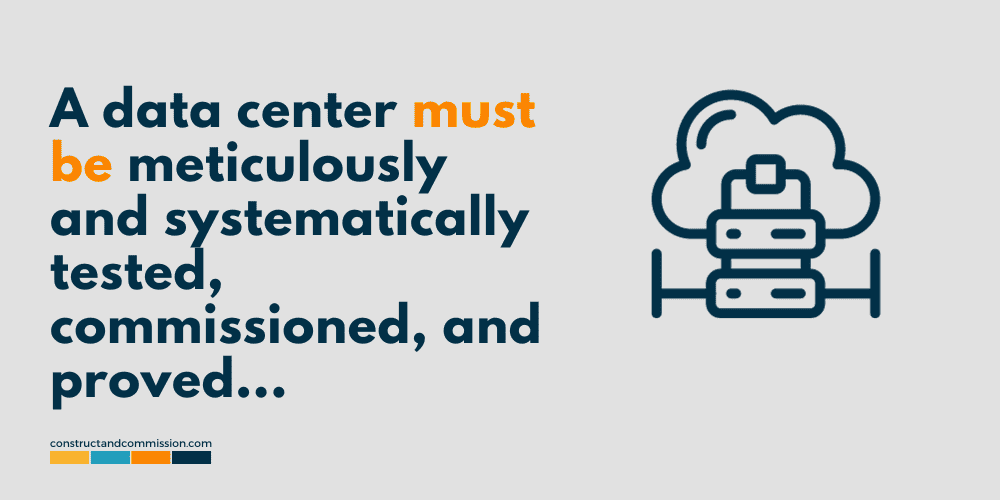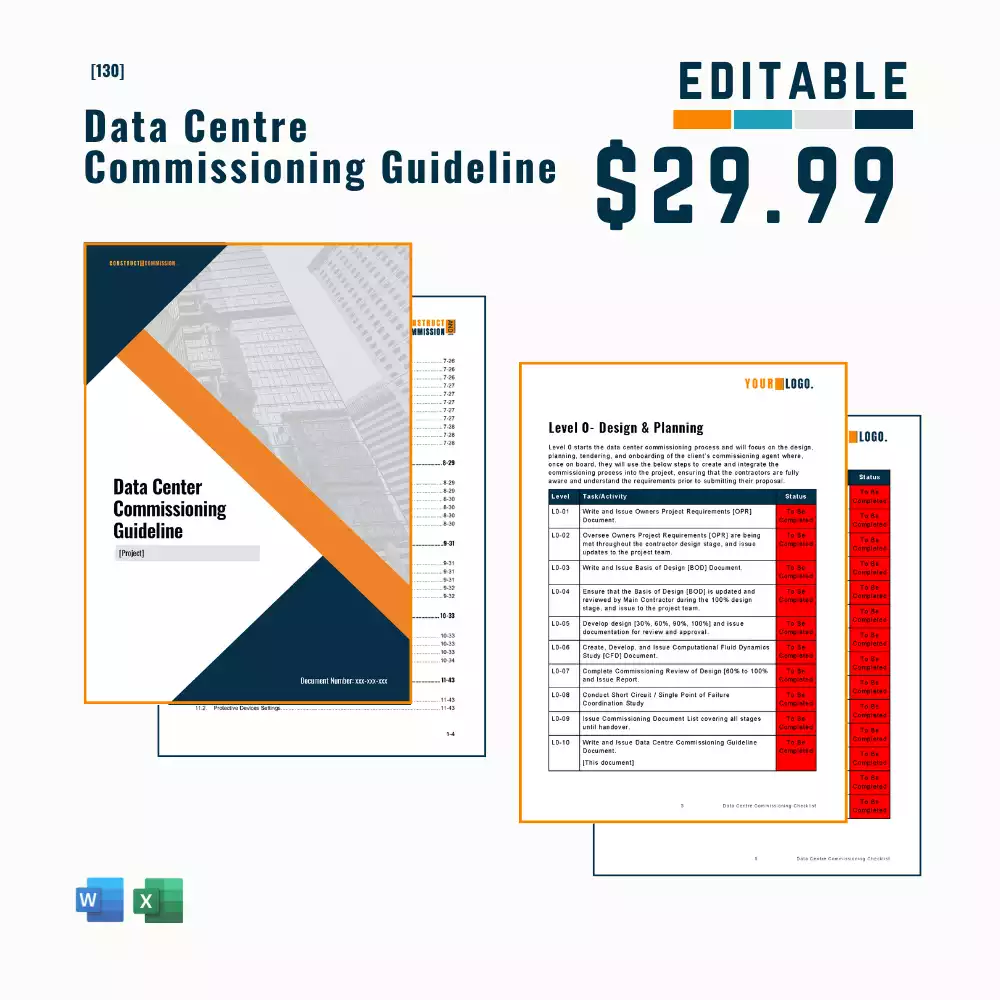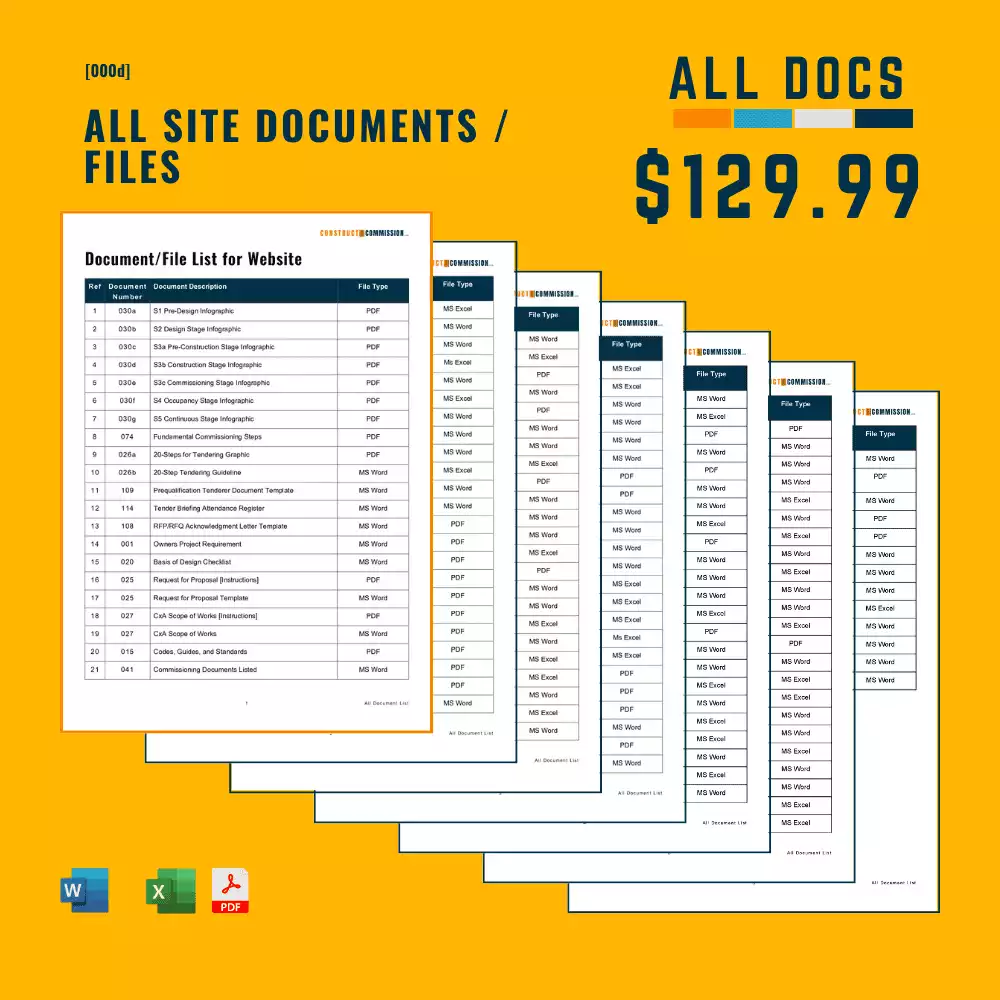Data centers play a pivotal role in our modern digital landscape, serving as the unseen hubs where vast amounts of information are stored, processed, and delivered across the internet and our various devices. The growth of digital data and the ever-increasing demand for online services underscores the critical importance of data centers in our daily lives.
To ensure that a data center functions with the utmost reliability, efficiency, safety, and uptime, it must be meticulously and systematically tested, commissioned, and proved before being put into operation, with the primary objective being to verify and validate that each component, system, and integration across the data center’s infrastructure.
In this article, we will cover ‘Data Center Commissioning Guidelines’, what they are, what they should include, how to create them, and their benefits, with a template included that can be purchased from our document store and used straight away on your projects to make life easier.

🟩 Benefits of using Commissioning Guidelines
Creating and using a commissioning guideline for a project can provide various benefits:
✅ Clarity of Expectations: If the guideline is written sufficiently, the overall client and project expectations will be clear, with detailed instructions about what is expected during the commissioning process. This will help eliminate ambiguity and ensure all parties understand their roles and responsibilities.
✅ Customization: Specifications can be tailored to the specific needs and goals of the data center project. They allow for flexibility in addressing unique requirements or challenges.
✅ Quality Assurance: A well-defined guideline can be a quality assurance tool, setting standards and criteria that must be met, helping maintain a high quality level throughout the commissioning process.
✅ Consistency: If a client is looking to construct multiple projects across various regions with different contractors, a well-written guideline is a great way to maintain consistency of the commissioning process/delivery.
✅ Documentation Requirements: Linked to the consistency above, a data center’s commissioning process will usually produce many documents. The formats and general requirements can be specified to ensure all are captured and created in line with the client’s needs.
✅ Resource Allocation: Helps in planning and allocating the correct resources, including time, personnel, and equipment, for the overall commissioning process.
✅ Reduced Disputes: With clear guidelines in place, there is less room for misunderstandings or disputes between project stakeholders. Any disagreements can often be resolved by referring to the document.
⬜ Useful Resources
We have written the following articles that would be useful when trying to understand the testing and commissioning of a data center.
- DATA CENTER COMMISSIONING | What is it?
- DATA CENTER | 0, 1, 2, 3, 4, 5, 6 Levels of Commissioning
- DATA CENTER TIERS | 1, 2, 3 & 4 Explained
- Data Center Redundancy | N, N+1, N+2, 2N & 2N+1 Explained
🟩 Key Components of a Guideline
Data Center Commissioning Guidelines should be written as a structured framework that covers the following components:
- Project Information: Detailing the specific information relating to the overall project.
- Overall Commissioning Process: Stipulate the process to be deployed by the General Contractor and overall commissioning team.
- Codes, Guides, and Standards: Detail the overall expectations and requirements relating to international codes, guides, and standards.
- Verification and Sampling Rates: Confirm the verification and sampling rates employed by the Owners Commissioning Management Consultant to ensure that the equipment, components, and systems are installed and operating per the design requirements.
- Team Information: Explain the commissioning team, including the roles used across the project within the Owner and General Contractor teams.
- Roles and Responsibilities: A detailed summary of the different tasks and activities should be provided within a matrix that notes the roles and responsibilities.
- Communication Protocol: To ensure that the team communicates efficiently and effectively through the process a ‘communication protocol’ should be included that details items such as communication channels, frequency, escalation, templates, language and tone.
- Electronic Platforms: Most projects utilize an electronic commissioning/document management platform for completing the commissioning tasks and activities. The guideline should detail the platforms that are to be used by the project, including any training requirements and document control.
- Meetings and Workshops: The expectations of the various commissioning meetings and workshops should be detailed to ensure that the team members understand and implement them when needed.
- Reporting: Reporting is critical to ensure that the overall commissioning process is documented and the stakeholders are kept up to date on the progress, including any issues. The types of reports should be detailed, what they should include, and their frequency.
- Programming and Logic: The format and expectations for the programme and any logics should be explained. This will ensure that all team members, more specifically the General Contractor, understand what is to be provided.
- Documentation: Include a section that details the types of documents that will be expected to be produced, and who produces them. If can, include a full list to ensure there are no misunderstandings.
- Document Formats: Detailing formats for the most critical documents will help provide an understanding to the General Contractor and Consultants of the expectations, minimizing any misunderstandings.
- System Studies: Make sure to include information on any systems studies that may be required, such as Discrimination, Arc Flash, and Computational Fluid Dynamics.
- Building Information Modeling: Where BIM is required to be deployed on the project, the guideline should include information that might affect the overall expectation of the commissioning process, such as attaching any information to the model.
- Strategies: If available, it would be helpful to include information on any strategies that may be required to be deployed due to the type of project. For example, strategies to work with existing systems, flushing and cleaning of pipework, energization and power on, drainage connections for condensate and water connections from the utilities.
- Training: This is a fundamental element to the successful handover and completion of a project from the construction/commissioning team to the building operator and facilities management company. The guideline should put focus on this, explaining the requirements and how training should be delivered.
- Tools and Instruments: If not clearly explained, Tools and instruments that are to be supplied by the General Contractors team can cause issues. Include a complete list of these, including who will install and supply them.
- Use Straight Away
- Insert in Tender Documents
- Industry Wide Process from Level 0 to Level 6
- Detailed Responsibility and Roles
- Includes Commissioning Checklist
Aimed at anyone who needs a detailed delivery plan and checklist for deploying Commissioning within a Data Center Project, this document is formatted in Microsoft Word/Excel and written so that it can be deployed quickly and easily with minimal updating to suit your specific needs.
[Once through to the shop there is a sample of the document to view]
- Easy
- Quick
- High Level
- Tracker
Here is our open copy [MS Word] & [MS Excel] of the Data Center Commissioning Checklist, for making life a little easier...
- 126No. Documents
- Use Straight Away
- Amazing Value
We have been asked several times to create a complete document package covering everything we have uploaded to the site.
So it's taken some time, but here it is....126No. Documents for you to download in Microsoft Word, Microsoft Excel & PDF Formats.
CLICK THE BUY HERE TO SEE/DOWNLOAD A FULL LIST OF DOCUMENTS INCLUDED...
🟩 Data Center Commissioning Process Overview
The commissioning process is a structured sequence of steps that ensures that every aspect of the data center is thoroughly tested and validated before it goes live. It typically involves:
- ⬛ LEVEL 0 | Design and Planning,
- 🟥 LEVEL 1 | Factory Testing,
- 🟨 LEVEL 2 | Component Delivery, Installation & Pre-Start-up,
- 🟩 LEVEL 3 | System Start-up,
- 🟦 LEVEL 4 | Functional Testing,
- ⬜ LEVEL 5 | Integrated System Testing,
- ⬛ LEVEL 6 | Closeout / Turnover / Handover
🔗 To read more detail on the process, these levels, and each task that should be completed, see our article | DATA CENTER | 0, 1, 2, 3, 4, 5, 6 Levels of Commissioning
⬜ Data Center Commissioning Guideline Template
To help us expand the site and create more resources, we made the document below in [Microsoft Word] & [Microsoft Excel] for download.
Click the ‘Buy Here‘ button to purchase the fully editable copy, which can be used immediately.
You will be directed to our shop page.
🚀 Includes a copy of the Data Center Commissioning Checklist shown at the end of this article.
⬛ Related Articles
CRAC UNITS | What are they?
CRAH UNIT | Pre-Functional CheckList
TIER V Platinum Data Center | What is it?
LEVEL 6 – DATA CENTER Cx | Turnover & Handover
CRAC UNIT | Pre-Functional CheckList
LEVEL 0 – DATA CENTER Cx | Design & Planning



![Data Center Commissioning Checklist [MS Word] & [MS Excel]](https://constructandcommission.com/wp-content/uploads/2023/07/066-Data-Center-Commissioning-Checklist-Shop.webp)
